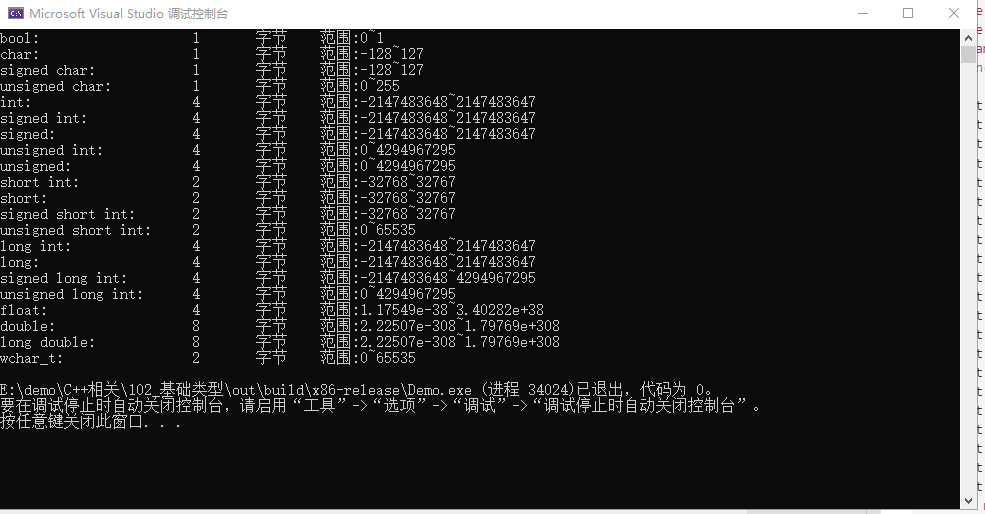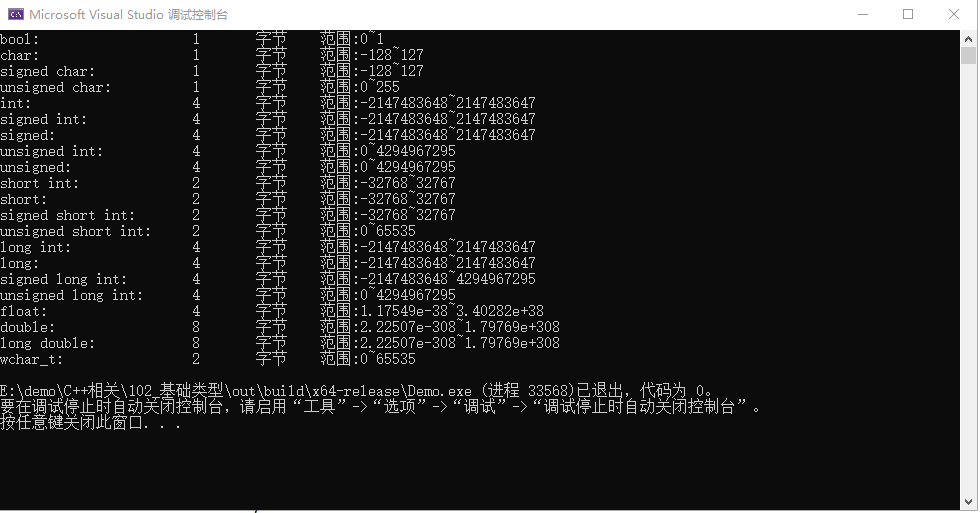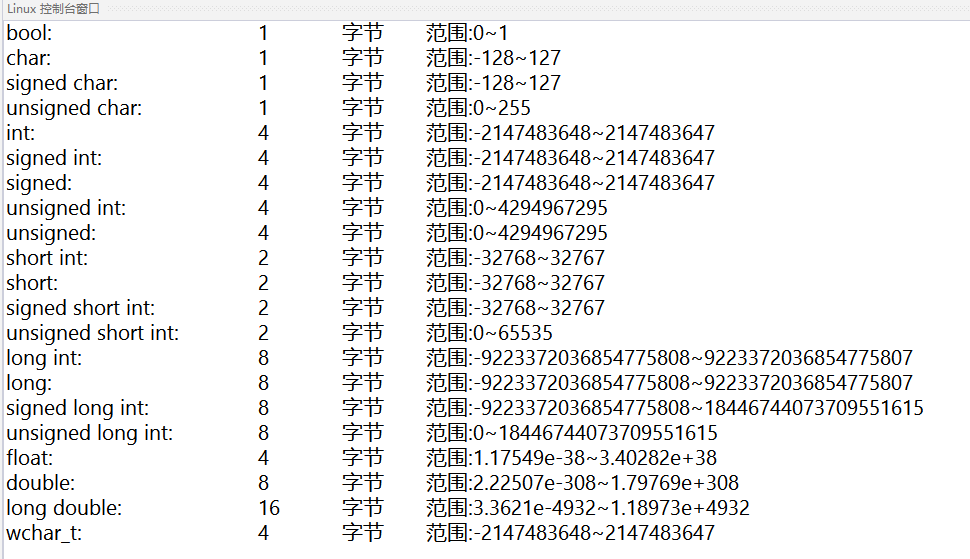 C++基础语法
C++基础语法
# 基础类型
C++的基础数据类型有:
bool : 处理 布尔类型 值 true 或 false;
char : 处理 字符类型数据;
int :处理 整型 数据
float :处理 浮点数
double : 处理 双精度浮点数
wchar_t(宽字符型):如果常量以 L(仅当大写时)开头,则表示它是一个宽字符常量(例如 L’x’),此时它必须存储在 wchar_t 类型的变量中。否则,它就是一个窄字符常量(例如 ‘x’),此时它可以存储在 char 类型的简单变量中。
void : 空类型
# 修饰符
除此外,还有类型修饰符:signed、unsigned、long 和 short
可以被类型修饰符修饰的类型有:int char 和 double
其中:
int 可以被 signed、unsigned、long 和 short 修饰 char 可以被 signed、unsigned 修饰 double 可以被 long 修饰
如果只写:signed、unsigned、long 和 short 等价于: signed int、unsigned int、long int 和 short int
# 范围
不同的编译器,数据类型的大小不同
#include <iostream>
#include <limits>
using namespace std;
int main(int argc, char* argv[])
{
cout << "bool:\t\t\t" << sizeof(bool) << "\t字节\t" << "范围:" << numeric_limits<bool>::min() << "~" << numeric_limits<bool>::max() << endl;
cout << "char:\t\t\t" << sizeof(char) << "\t字节\t" << "范围:" << (int)numeric_limits<char>::min() << "~" << (int)numeric_limits<char>::max() << endl;
cout << "signed char:\t\t" << sizeof(signed char) << "\t字节\t" << "范围:" << (int)numeric_limits<signed char>::min() << "~" << (int)numeric_limits<signed char>::max() << endl;
cout << "unsigned char:\t\t" << sizeof(unsigned char) << "\t字节\t" << "范围:" << (int)numeric_limits<unsigned char>::min() << "~" << (int)numeric_limits<unsigned char>::max() << endl;
cout << "int:\t\t\t" << sizeof(int) << "\t字节\t" << "范围:" << numeric_limits<int>::min() << "~" << numeric_limits<int>::max() << endl;
cout << "signed int:\t\t" << sizeof(signed int) << "\t字节\t" << "范围:" << numeric_limits<signed int>::min() << "~" << numeric_limits<signed int>::max() << endl;
cout << "signed:\t\t\t" << sizeof(signed) << "\t字节\t" << "范围:" << numeric_limits<signed>::min() << "~" << numeric_limits<signed>::max() << endl;
cout << "unsigned int:\t\t" << sizeof(unsigned int) << "\t字节\t" << "范围:" << numeric_limits<unsigned int>::min() << "~" << numeric_limits<unsigned int>::max() << endl;
cout << "unsigned:\t\t" << sizeof(unsigned) << "\t字节\t" << "范围:" << numeric_limits<unsigned>::min() << "~" << numeric_limits<unsigned>::max() << endl;
cout << "short int:\t\t" << sizeof(short int) << "\t字节\t" << "范围:" << numeric_limits<short int>::min() << "~" << numeric_limits<short int>::max() << endl;
cout << "short:\t\t\t" << sizeof(short) << "\t字节\t" << "范围:" << numeric_limits<short>::min() << "~" << numeric_limits<short>::max() << endl;
cout << "signed short int:\t" << sizeof(signed short int) << "\t字节\t" << "范围:" << numeric_limits<signed short int>::min() << "~" << numeric_limits<signed short int>::max() << endl;
cout << "unsigned short int:\t" << sizeof(unsigned short int) << "\t字节\t" << "范围:" << numeric_limits<unsigned short int>::min() << "~" << numeric_limits<unsigned short int>::max() << endl;
cout << "long int:\t\t" << sizeof(long int) << "\t字节\t" << "范围:" << numeric_limits<long int>::min() << "~" << numeric_limits<long int>::max() << endl;
cout << "long:\t\t\t" << sizeof(long) << "\t字节\t" << "范围:" << numeric_limits<long>::min() << "~" << numeric_limits<long>::max() << endl;
cout << "signed long int:\t" << sizeof(signed long int) << "\t字节\t" << "范围:" << numeric_limits<signed long int>::min() << "~" << numeric_limits<unsigned long int>::max() << endl;
cout << "unsigned long int:\t" << sizeof(unsigned long int) << "\t字节\t" << "范围:" << numeric_limits<unsigned long int>::min() << "~" << numeric_limits<unsigned long int>::max() << endl;
cout << "float:\t\t\t" << sizeof(float) << "\t字节\t" << "范围:" << numeric_limits<float>::min() << "~" << numeric_limits<float>::max() << endl;
cout << "double:\t\t\t" << sizeof(double) << "\t字节\t" << "范围:" << numeric_limits<double>::min() << "~" << numeric_limits<double>::max() << endl;
cout << "long double:\t\t" << sizeof(long double) << "\t字节\t" << "范围:" << numeric_limits<long double>::min() << "~" << numeric_limits<long double>::max() << endl;
cout << "wchar_t:\t\t" << sizeof(wchar_t) << "\t字节\t" << "范围:" << numeric_limits<wchar_t>::min() << "~" << numeric_limits<wchar_t>::max() << endl;
return 0;
}
2
3
4
5
6
7
8
9
10
11
12
13
14
15
16
17
18
19
20
21
22
23
24
25
26
27
28
使用:Microsoft Visual C++ x86

使用:Microsoft Visual C++ x64

使用: Ubuntu GCC

# 基础运算符
| 优先权 | 运算符 | 说明 | 结合性 |
|---|---|---|---|
| 1 | () | 括号 | 由左至右 |
| 2 | !、-、++、-- | 逻辑运算符NOT、算术运算符负号、递增、递减 | 由右至左 |
| 3 | *、/、% | 算术运算符的乘法、除法、余数 | 由左至右 |
| 4 | +、- | 算术运算符加法、减法 | 由左至右 |
| 5 | <<、>>、>>> | 位操作子左移、右移、无符号右移 | 由左至右 |
| 6 | >、>=、<、<= | 关系运算符大于、大于等于、小于、小于等于 | 由左至右 |
| 7 | ==、!= | 关系运算符等于、不等于 | 由左至右 |
| 8 | & | 位操作子AND | 由左至右 |
| 9 | ^ | 位操作子XOR | 由左至右 |
| 10 | | | 位操作子OR | 由左至右 |
| 11 | && | 逻辑运算符AND | 由左至右 |
| 12 | || | 逻辑运算符OR | 由左至右 |
| 13 | ?: | 条件控制运算符 | 由右至左 |
| 14 | =、op= | 指定运算符 | 由右至左 |
op= 这里指: += 、 -= 、 *= 、 \= 、 %= 、 &= 、 ^= 、 |=
# 引用
在前面一篇我们知道,变量是内存地址的一个名字;引用是给一个已经有名称的内存地址,再起一个名字。
看下面代码,做一下深入理解:
/*
* 引用
* 类型 & 引用变量名 = 引用实体;
*/
void test1()
{
int a = 1; // 声明并初始化 int 类型变量 a
int& b = a; // 定义引用类型 b,指向 变量a
cout << b << endl;
int& c = b; // 定义引用类型 b,指向 变量b
cout << c << endl;
cout << &a << endl; // 输出a的内存地址
cout << &b << endl; // 输出b的内存地址
cout << &c << endl; // 输出c的内存地址
}
2
3
4
5
6
7
8
9
10
11
12
13
14
15
16
结果:
1
1
0x7fffffffe464
0x7fffffffe464
0x7fffffffe464
引用 不是新定义一个变量,而 是给已存在变量取了一个别名 ,编译器不会为引用变量开辟内存空间,它和它引用的变量共用同一块内存空间。
# 指针&指针初始化
指针(pointer)是 C++中的一个核心概念;是c++中常见的用来存在内存的一种工具。
理解指针有两个点:
- 指针本身是一个大小等于int类型的变量。
- 指针内存储着它指向的值的地址。
void test1()
{
int a = 1; // 声明并初始化 int 类型变量 a
int* ptr; // 声明int类型指针 ptr
ptr = &a; // 让指针ptr指向 变量a 的地址
cout << ptr << endl; // 输出 指针指向的地址
cout << *ptr << endl; // 输出 指针指向的地址的值
cout << &ptr << endl; // 输出 指针的地址
}
2
3
4
5
6
7
8
9
结果:
0x7fffffffe46c
1
0x7fffffffe470
以上demo,指针是指向栈对象,其实在正式的编程工作中,指针大多是指向堆对象的。
栈对象 和 堆对象的区别,我们会在后续讲解。
堆对象 的 创建 和 释放 是需要特殊的关键字;
C++中 一共有两对关键字:
malloc,free (C++,兼容C;所以可以用C的关键字)
new,delete (C++新增,常用这一对)
这里注意: free 和 delete 是 释放指针指向地址的内存,这时指针依然指向对应地址,不为空。
这时需要给指针赋空值,否则后续无法判断指针指向的位置是否有效,就会形成野指针。
同理,在声明一个指针是,通常就应该初始化;如果暂不确定值,可以赋空,防止野指针。
# malloc & free
malloc 和 free 的一般形式:
void *malloc(size_t size)
void free(void *ptr)
2
malloc 分配指定大小为 size字节的内存空间,返回一个指向该空间的void指针。 由于返回 void 指针,所以需要强制类型转换后才能引用其中的值。
free 释放一个由 malloc 所分配的内存空间。ptr 指向一个要释放内存的内存块, 该指针应当是之前调用 malloc 的返回值。
void test3()
{
int* ptr = nullptr; // 通常指针变量声明时,就应该初始化;如果暂不确定值,可以赋空,防止野指针。
ptr = (int*)malloc(sizeof(int)); // 申请一个int大小的堆内存,并进行强制类型转换
*ptr = 1; // 对ptr指向的位置赋值
cout << *ptr << endl; // 输出
free(ptr);
ptr = nullptr;
}
2
3
4
5
6
7
8
9
结果:
1
0x55555556aeb0
0x55555556aeb0
# new & delete
new & delete 的一般形式:
类型* 指针名 = new 类型();
delete 指针名
2
new 按照类型的大小,分配内存。 delete 释放指针指向地址的内存,这是指针依然指向对应地址,不为空。 通常会在 delete 后,增加一个 给指针变量赋空的操作;防止野指针。
void test4()
{
int* ptr = new int(4); // 声明并初始化 int类型 指针 ptr
cout << ptr << endl; // 输出 ptr 指向的地址
cout << *ptr << endl; // 输出 ptr 指向地址的值
delete ptr;
cout << ptr << endl; // 输出 ptr 指向的地址
cout << *ptr << endl; // 输出 ptr 指向地址的值
ptr = nullptr;
}
2
3
4
5
6
7
8
9
10
结果:
0x55555556aeb0
4
0x55555556aeb0
1431655786
# 数组
以int类型举例:
当声明一个int类型的变量a,是在内存中声明了一个int类型大小(4Byte,32Bit)的内存
当声明一个int类型的数组array,是在内存中声明了一组连续的int类型大小(4Byte,32Bit)的内存
# 基本操作(初始化和下标访问)
数据申明的基本形式:
类型 参数[数量]
访问数组时,使用数组下标,下标从0开始。
# 初始化1
已知数组大小,和所有元素的值。
void demo()
{
int array[2] = { 1, 2 };
cout << array[0] << endl;
cout << array[1] << endl;
}
2
3
4
5
6
结果为:
1
2
这种情况下也可以省略数组大小不写,结果等价。
# 初始化2
已知数组大小,和有元素的值,且值相同。
void demo()
{
int array[2] = { 1 };
cout << array[0] << endl;
cout << array[1] << endl;
}
2
3
4
5
6
结果:
1
1
# 初始化3
已知数组大小,值暂不清晰。
void demo()
{
int array[2];
array[0] = 0;
array[1] = 1;
cout << array[0] << endl;
cout << array[1] << endl;
}
2
3
4
5
6
7
8
# 未初始化
未初始化的数据为当前内存位置存的随机值(内存中本来的值)。
存在两种为初始的情况: 1、数组刚声明,未赋值。 2、数组访问下标越界,虽然还是可以访问,但是值为随机值。
void demo()
{
int array1[2];
cout << array1[0] << endl;
cout << array1[1] << endl;
int array2[2] = {0};
cout << array2[0] << endl;
cout << array2[1] << endl;
cout << array2[2] << endl;
}
2
3
4
5
6
7
8
9
10
11
结果:
-135408993
32767
0
0
-135408993
2
3
4
5
6
# 栈数组和堆数组(数组动态分配)
栈数组:内容存储在栈中的数组。 上面的demo其实就是栈数组。 这样的数组有一个弊端,需要在写代码时,就定义好数组大小。
如果我们暂时不知道数组的大小;需要在运行时决定数组大小,就需要堆数组;对数组大小进行动态分配。
堆数组:内容存储在堆中的数组。 C++如果想把内存分配到堆上,就需要使用 C++操作堆的两组关键字:
malloc,free (C++,兼容C;所以可以用C的关键字)
new,delete (C++新增,常用这一对)
具体理解查看下面的demo:
# malloc & free
void demo5()
{
int n = 2; // 定义数组的大小
int* grade = (int*)malloc(sizeof(int) * n); // 创建数组 数组大小:int类型的大小 * n 。
cout << sizeof(grade) << endl; // 输出 grade 大小
cout << grade << endl; // 输出:指针的执行的位置
cout << &grade[0] << endl; // 输出:数组0号位的位置
cout << &grade[1] << endl; // 输出:数组1号位的位置
// 输出默认值
cout << grade[0] << endl;
cout << grade[1] << endl;
grade[0] = 0; // 给数组0号位赋值
grade[1] = 1; // 给数组1号位赋值
// 输出 赋值后结果
cout << grade[0] << endl;
cout << grade[1] << endl;
free(grade);
}
2
3
4
5
6
7
8
9
10
11
12
13
14
15
16
17
18
19
20
21
22
结果:
8
0x55555556aeb0
0x55555556aeb0
0x55555556aeb4
0
0
0
1
# new & delete
需要注意的是 数组的操作符方式为: new[] 和 delete[]
一般形式为:
类型* 指针名 = new 类型[n]; // n 为数组个数
delete[] 指针名
2
void demo6()
{
int n = 3; // 定义数组的大小
int* grade = new int[n]; // 创建数组 数组大小:int类型的大小 * n 。
cout << sizeof(grade) << endl; // 输出 grade 大小
cout << grade << endl; // 输出:指针的执行的位置
cout << &grade[0] << endl; // 输出:数组0号位的位置
cout << &grade[1] << endl; // 输出:数组1号位的位置
// 输出默认值
cout << grade[0] << endl;
cout << grade[1] << endl;
grade[0] = 0; // 给数组0号位赋值
grade[1] = 1; // 给数组1号位赋值
// 输出 赋值后结果
cout << grade[0] << endl;
cout << grade[1] << endl;
delete[] grade;
}
2
3
4
5
6
7
8
9
10
11
12
13
14
15
16
17
18
19
20
21
22
结果:
8
0x55555556aeb0
0x55555556aeb0
0x55555556aeb4
0
0
0
1
# 指针和数组的关系
从以上demo可以发现:堆数组是用指针的方式操作数组;来实现在运行期再决定数组大小的目的。
现在的问题是 为什么我们可以这么做嗯?
这是因为编译器在处理指针的 [n],++,--,+ n,- n 操作时,是按 对应类型大小 的 往上或往下找到第n个位置。
即 指针,可以通过这样的方式操作连续内存,这恰好和数据契合;所以我们可以用指针来操作数组。
但指针和数组是两个概念。
# 常用语句
C++ 常用语句有:
1、赋值语句
2、条件语句
3、循环语句
4、try...catch...throw
# 赋值语句
一般形式为:
value = exp;
value 为变量,exp为可求值的表达式。
例:
int a = 0;
a = 1 + 1;
2
3
4
5
第一句 初始一个int类型变量a,并赋值为0; 第二句 求1 + 1 的值,并赋给 a;
# 条件语句
# if else
一般形式为:
if (exp)
{
// 程序代码
}
else
{
// 程序代码
}
2
3
4
5
6
7
8
exp 为求值为bool 类型的表达式。 程序代码中可以继续嵌套 if else 已完成复杂逻辑判断。
如果只有为true的条件需要特殊的程序代码:
if (exp)
{
// 程序代码
}
2
3
4
如果有多个并列的不同条件:
if (exp1)
{
// 程序代码
}
else if (exp2)
{
// 程序代码
}
else
{
// 程序代码
}
2
3
4
5
6
7
8
9
10
11
12
# 三元运算符
一般形式:
condition ? exp1 : exp2;
执行方式为:先执行 condition; condition为true,结果为exp1的值; condition为false,结果为exp2的值。
# switch
如果我们存在大量使用多个并列的不同条件需要判断,也可以使用switch。
一般形式:
switch (exp) {
case condition_exp1:
// 程序代码1
break;
case condition_exp2:
// 程序代码2
break;
case condition_exp3:
// 程序代码3
break;
default:
// 程序代码4
break;
}
2
3
4
5
6
7
8
9
10
11
12
13
14
exp、condition_exp1、condition_exp2 ... 可 计算为 int类型,或者为 枚举类型。
逻辑为:exp求出的值,等于 哪一个 condition_exp;代码就跳转到那里执行,到break为止。
如果没有,就执行 default。
例1:
int a = 2;
switch (a)
{
case 1:
cout << "case 1" << endl;
break;
case 1 + 1 :
cout << "case 2" << endl;
break;
default:
cout << "case default" << endl;
break;
}
2
3
4
5
6
7
8
9
10
11
12
13
运行结果:
case 2
例2:
switch (1 + 1)
{
case 1+0:
cout << "case 1" << endl;
case 2:
cout << "case 2" << endl;
default:
cout << "case default" << endl;
break;
}
2
3
4
5
6
7
8
9
10
运行结果:
case 2
case default
2
# 循环语句
# while
一般形式:
while (condition)
{
循环体代码
}
2
3
4
例:计算 1 + 2 + 3 + ··· + 10 的结果
void while_demo()
{
int i = 1;
int amont = 0;
while (i <= 10)
{
amont += i;
i++;
}
}
2
3
4
5
6
7
8
9
10
# do... while
一般形式:
do
{
循环体代码
} while (condition)
2
3
4
例:计算 1 + 2 + 3 + ··· + 10 的结果
void do_while_demo()
{
int i = 1;
int amont = 0;
do
{
amont += i;
i++;
} while (i <= 10);
}
2
3
4
5
6
7
8
9
10
# for
一般形式:
for ( init ; condition ; increment )
{
循环体代码
}
2
3
4
例:计算 1 + 2 + 3 + ··· + 10 的结果
void for_demo()
{
int amont = 0;
for (int i = 1; i <= 10; i++)
{
amont += i;
}
}
2
3
4
5
6
7
8
# try...catch...throw
当执行一段语句可能发生异常时,就需要将这段代码保护起来。
一般形式:
try
{
保护块代码:
包含:
throw
}
cacth (ExceptionName e1)
{
cacth块代码1:处理异常1的情况
}
cacth (ExceptionName e2)
{
cacth块代码2:处理异常2的情况
}
cacth (...)
{
cacth块代码 ... :处理剩下的所有异常
}
2
3
4
5
6
7
8
9
10
11
12
13
14
15
16
17
18
19
throw : 抛出异常 try : 执行保护代码中,一般包含throw catch : 接收处理异常
# Demo & 理解throw
throw 在未被命中前,将跳过后续的所有代码;如果一直没有被处理,就会被系统接收,导致当前程序崩溃。
demo1: 正常命中异常
void try_catch_deom()
{
try
{
cout << "This is before throw" << endl;
throw 1;
cout << "This is after throw" << endl;
}
catch (int num)
{
cout << "This is catch int" << endl;
}
}
int main(int argc, char* argv[])
{
try_catch_deom();
cout << "this is after demo" << endl;
return 0;
}
2
3
4
5
6
7
8
9
10
11
12
13
14
15
16
17
18
19
20
21
22
23
结果:
This is before throw
This is catch int
this is after demo
demo2: 由...命中异常
void try_catch_deom()
{
try
{
cout << "This is before throw" << endl;
throw 1.1;
cout << "This is after throw" << endl;
}
catch (int num)
{
cout << "This is catch int" << endl;
}
}
int main(int argc, char* argv[])
{
try
{
try_catch_deom();
cout << "this is after demo" << endl;
}
catch (...)
{
cout << "This is catch ..." << endl;
}
return 0;
}
2
3
4
5
6
7
8
9
10
11
12
13
14
15
16
17
18
19
20
21
22
23
24
25
26
27
28
结果:
This is before throw
This is catch ...
demo3: 无接收
int main(int argc, char* argv[])
{
throw 1;
return 0;
}
2
3
4
5
结果:程序崩溃
